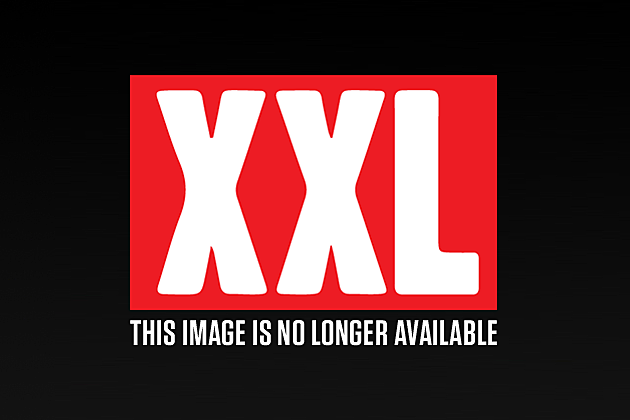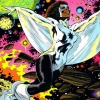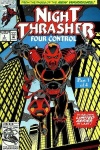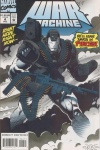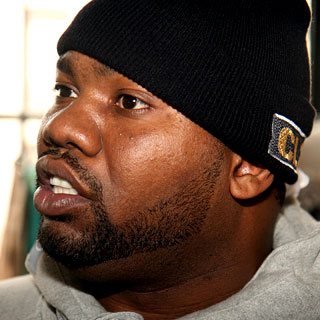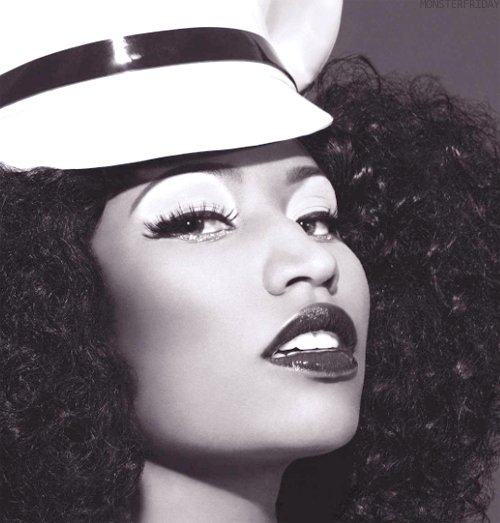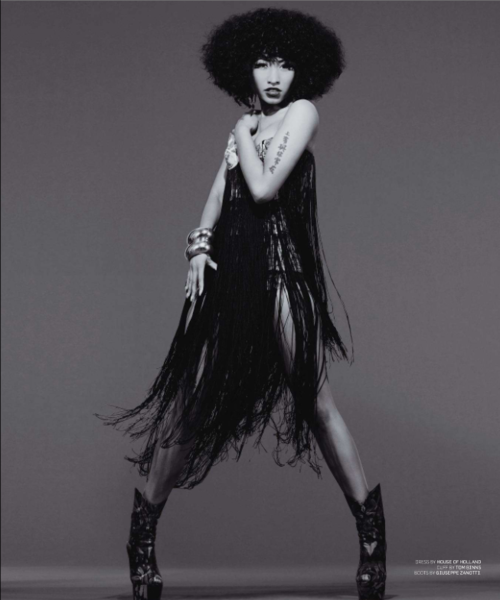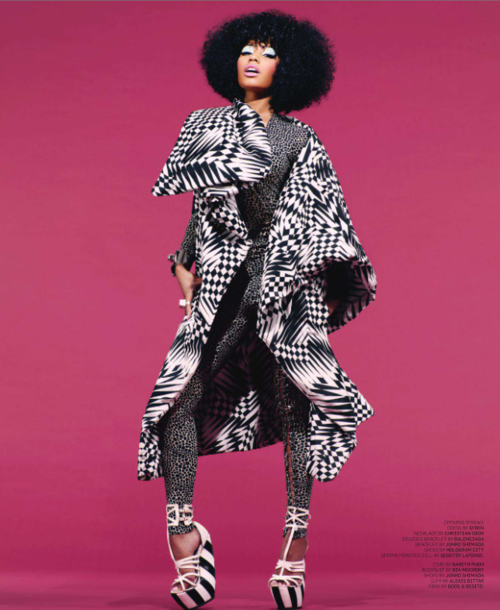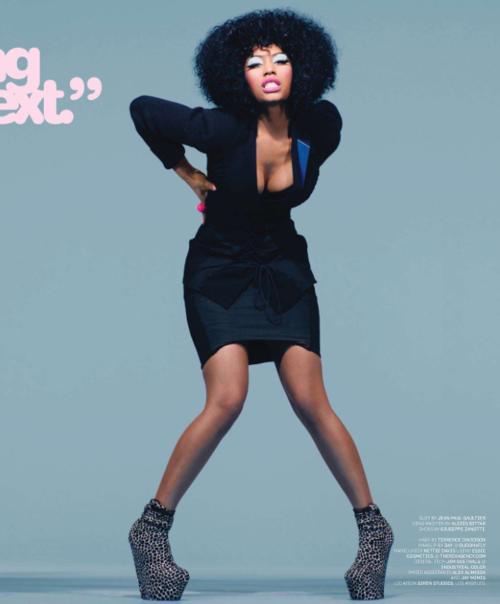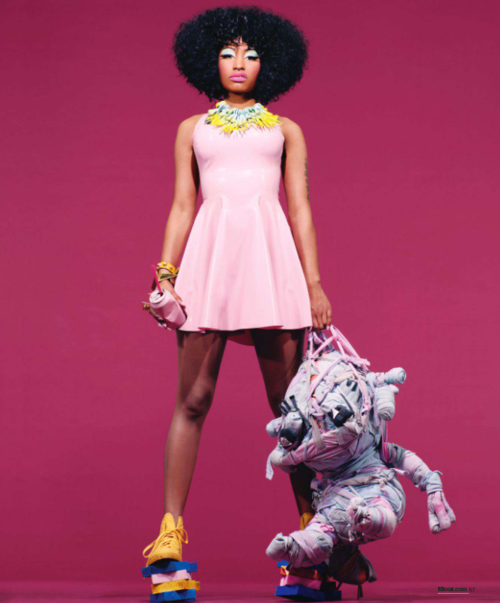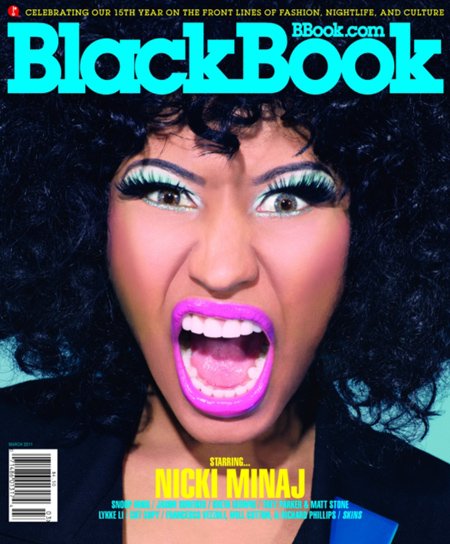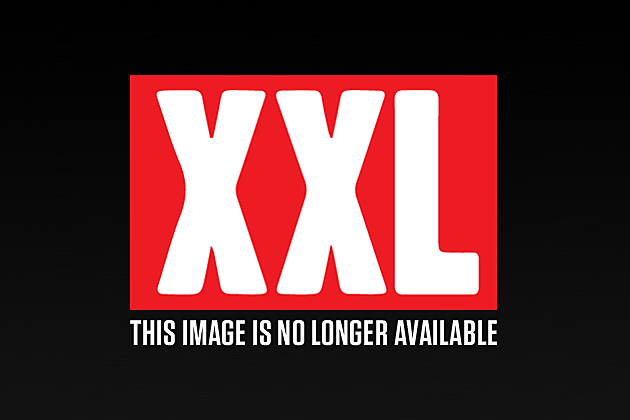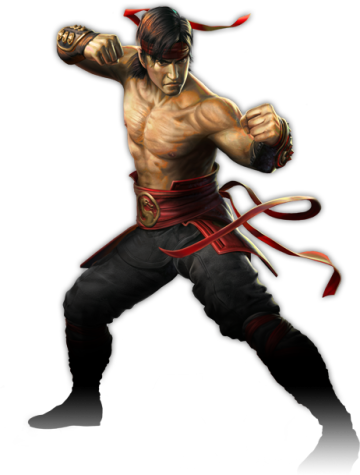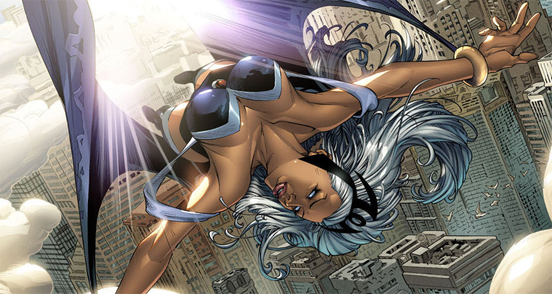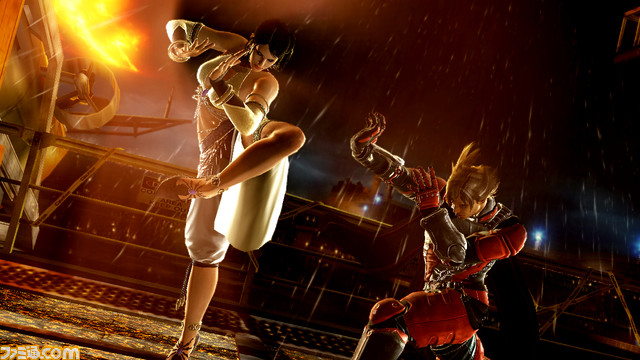Monday, February 28, 2011
Ninja Gaiden 3 OFFICIAL Teaser Trailer [WATCH]
Wiz Khalifa - "Rolling Papers" ALBUM COVER
Labels:
Album Cover,
Hiphop,
Rap,
Rolling Papers,
Wiz Khalifa
Wiz Khalifa - "Roll Up" MUSIC VIDEO [WATCH]
Labels:
Hiphop,
Music,
Music Video,
Pop,
Rap,
Wiz Khalifa
A Marvel Comics Black History Lesson Pt. 2
By David Brothers
Roger Stern and John Romita Jr. created Monica Rambeau, also known as Captain Marvel and Photon, in 1982's AMAZING SPIDER-MAN ANNUAL #16. Despite no blood relation or shared powers with her predecessor, Rambeau became a legacy character entirely by accident. After her debut, the media began calling her Captain Marvel. While she wasn't entirely comfortable with taking up a dead man's name, her friends in the Avengers convinced her that she was worthy of the title. She later ceded the title to Mar-Vell's son out of respect, and took the name Photon.
Rambeau's a character that has a strong need to do right, no matter where she is. Characters like Iron Man, Spider-Man, and Luke Cage needed a reason to become heroes. Rambeau, however, is more in the Captain America mold. Like Steve Rogers, she's driven to serve the public. While Captain America volunteered for a dangerous experiment to serve his country, Rambeau spent years serving as part of the New Orleans Harbor Patrol. Getting powers merely gave her another way to serve the public, and becoming the leader of the Avengers gave her yet another way to help.
Night Thrasher, who first appeared in 1989's THOR #411, represents a different mentality. While the majority of Marvel's black heroes were set in that nebulous age group where they're old enough to be successful—Rambeau was a lieutenant in the Harbor Patrol, for example, and Luke Cage was far out of his misspent youth—Night Thrasher and his New Warriors were explicitly meant to be the younger generation of Marvel heroes. As a result, he was much edgier than his predecessors; angrier, and more violent.
Rather than being driven to serve by an innate sense of honor, Night Thrasher began his career out of a thirst for vengeance. His parents were murdered before his eyes as a child, which introduced him to the harsh realities of life. His quest for vengeance soon grew into an obsessive loathing for all crime everywhere; a less than noble motivation for heroism, to be sure, but one that, again, managed to tap right into the zeitgeist.
1989—honestly, all of the late 80’s—was a good year for hip-hop. Rap was in the process of splintering into several different lanes. 2 Live Crew was busy flirting with the legal definition of obscenity at the same time that Boogie Down Productions was attempting to teach the youth about how to live life. While Ice-T and N.W.A. were turning gangsta rap into a household name, Afro-centrism was also gaining steam, promoting confidence via the shared history of black America.
Rap music, the music of the young black Americans, was growing into something new. A lot of the content was angry, intelligent, and shocking. Songs about violence, real life, despair, and sex were big, and being beamed directly into the homes of millions of Americans. Night Thrasher, at least on a certain level, was keyed into these newly public feelings. His hatred of injustice and violent outbursts reflected the emotions across a surprisingly broad spectrum of rap music.
“Tom DeFalco and Ron Frenz created Dwayne Taylor/Night Thrasher when they first conceived of the New Warriors concept,” notes longtime NEW WARRIORS and NIGHT THRASHER writer Fabian Nicieza. “Tom wanted all of us to keep character diversity in mind when developing new concepts, since that was always a hallmark of Marvel, so as Editor-in-Chief at the time, he put his money where his mouth is and helped created diversity for the Warriors by making Thrash African-American.
“I remember trying to focus very much on two things: making his skin color secondary to anything he did as a character or how other characters reacted to him and try to tone down the ‘driven by vengeance’ [motivation] and quickly evolve it into an understanding on his part that he should be ‘driven for justice,’ which is a big difference. I guess a [third] caveat was also to try and find either a way to make the skateboard work or find a way to minimize it. We found a way to minimize it by not using it!”
In 1990, Dwayne McDuffie, Gregory Wright, and Jackson Guice brought us DEATHLOK #1, which reintroduced Deathlok to the Marvel Universe in a new guise: a black scientist. Michael Collins thought he was working on high-tech prosthetic limbs, but soon found that he was in fact creating technology for a new type of weapons system. Betrayed by his employer and implanted in the Deathlok machine, Collins is faced with a horrific scenario. He wants to work to help people, to do the opposite of what his newfound body is programmed to do. He's trapped in what may well be his worst nightmare, with little hope of escape.
Collins' fate actually mirrors some of the content found in the music around this time. The way Deathlok's dilemma parallels black history isn't hard to see. If you consider that Deathlok can easily be a metaphor for being forced to live in the projects or to break the law to feed your family, things begin falling into place. You didn't ask for it, you don't want to be there, but you have a very, very small chance of breaking out. Deathlok, then, was about freedom. The freedom to escape your circumstances, to rise above the fate you've been given, and the freedom to be your own man.
James Rhodes had filled in as Iron Man for Tony Stark off and on since 1983, but in 1992, he hit the comic shops in his own title, WAR MACHINE. While Iron Man was an Avenger and a traditional super hero, War Machine was a walking armory. He built on the foundation laid by Night Thrasher and Deathlok. He was angrier and edgier than Iron Man, but embraced the violence, rather than rejecting it out of hand. War Machine saw his methods and weapons as the lesser of two evils, and it was better for him to commit a few small sins than for injustice to win. His methods led him to butt heads with several super heroes, but he maintained the necessity of his war.
War Machine represents that part of us that sees or is a victim of wrongdoing and wants to lash out. Peaceful protest only goes so far, and War Machine showed us what it could be like to become proactive. War Machine is a man willing to make hard choices, and while that's tough to justify sometimes, it definitely has its own appeal. It's hard to say whether someone would behave otherwise if they found themselves with the power Rhodey possessed.
Almost 10 years later, in 2001, The Anarchist, also known as Tike Alicar, made his debut in X-FORCE #116. The creative freedom that Peter Milligan and Mike Allred had allowed them more freedom to portray and explore race than Stan Lee and Jack Kirby had when they created Gabe Jones. Alicar, who was adopted by a white Canadian family and whose mutant power was sweating acid, openly called himself the "token black guy" of X-Statix.
This overt reference to how super hero teams used to be formed—generally one black guy, one or two ladies, and the rest of the team a variety of white males—wasn't new or revolutionary, but it was refreshing. X-STATIX concerned itself with how super heroes interacted with each other on every level, from romantic relationships to team dynamics, and race was no exception. While there were no grand speeches about the evils of stereotyping or suggestions on how to cure institutionalized racism, X-STATIX did something with race that had rarely been done beforehand: it acknowledged it existed without approaching it as a problem to be solved. Tike was black, secure, and confident. He didn't have to prove his blackness or take part in “A Very Special Issue” of X-STATIX to prove that. He simply was who he was.
“The Anarchist was a key figure in the love triangle that was Mister Sensitive, U-Go Girl and himself in the strange X-brew that was X-Statix,” says Milligan. “As such he was a vitally important character who killed a lot of less vitally important characters. What I liked about him was that while his ‘blackness’ was a key part of who he was it wasn’t all he was. He also suffered from OCD. I was very fond of this character, his sometimes brash performance being a nice foil for Mister Sensitive’s…sensitivity.”
“Tike Alicar uttered the immortal words, ‘I’m a black mutant—that’s like being black with a little black added,’” recalls Marvel Editor-in-Chief and X-FORCE/X-STATIX editor Axel Alonso. “I think he was stepping out of a hot tub, leaving behind two bikini-clad beauties at the time. The Comics Code didn’t approve—and the rest is history. Needless to say, Tike was a real character. More than a pint of anger in him, but also gallons of compassion and heart born of experience. I really, really miss him.”
2001 featured the introduction of another black character that made waves. Ultimate Nick Fury added a layer of Samuel L. Jackson cool to the superspy that Lee, Kirby, and Jim Steranko built, and the results were fantastic and thoroughly modern. 2001 isn't 1963, and black characters are on an equal footing with white ones. Your war hero/superspy/military leader of the free world doesn't have to be a Pop Art-inspired, incredibly stylish, cigar-smoking white guy any more. A bald, gruff, and smooth-talking black man can fill the role just as easily, as Bryan Hitch and Mark Millar proved in the pages of THE ULTIMATES.
Ultimate Nick Fury isn't just a carbon copy of the original, either. He has his own quirks, including a willingness to be extremely sneaky and underhanded, and gets up to things that his forefather wouldn't. He's a product of modern-day politics and culture, and an interesting and multi-faceted update of a classic Marvel character.
He also answers an oft-asked question: "Why can't these characters be another race?" There's very little about Nick Fury that explicitly requires him to be a white male, so when given the chance to switch things up, a black Nick Fury actually makes narrative sense. After all, General Colin Powell had been both United States Secretary of State and Chairman of the Joint Chiefs of Staff. Fury, in his own way, represented how far black characters had come since 1963. They could be the boss, and not only that, but a boss that sometimes made decisions we'd consider wrong.
"I hate to say it, but the Samuel L Jackson Nick Fury visual came from Bryan Hitch,” says Millar of the character’s resemblance to the Hollywood actor who would ultimately portray him in “Iron Man” and other Marvel big screen endeavors. “I'd love to take the credit, but all I said was ‘Cool, African American guy’ and Hitchy came back with SLJ, which was of course genius on his part.
“The reason I changed him from the Caucasian look is that I felt the classic 60’s Rat Pack era Nick was great, but a little dated for a modern audience. It was classic cool or even retro cool as opposed to what a little guy in 2001 would have found to be a cool super-spy. Jackson was and always will be the coolest man alive so he was a perfect choice for that effortless, laid-back swagger the head of S.H.I.E.L.D. should always exude. Colin Powell was my original inspiration when I first put him in ULTIMATE X-MEN #8, because he had held a similar, real-life position not long before. But he didn't look as good in a leather jacket as the guy Hitchy morphed him into."
What's nice about comics is that even the trailblazers get a chance to take advantage of the benefits they helped create. James Rhodes is currently headlining his own series, IRON MAN 2.0, with a high-profile launch and an all-star creative team. He played a major role during the Dark Reign status quo, taking the battle directly to the people who deserved it most.
Black Panther's reintroduction to the Marvel Universe courtesy of Reggie Hudlin and John Romita Jr. in 2005 elevated the character to sales and prestige he hadn't seen in years. Hudlin's take blended black American culture with the African super hero, and was a version of the Panther that had a lot to love. Hudlin took T’Challa from the jungle to space and back again in stories that were intended to entertain and brought a certain amount of authenticity to the series.
One of the highlights of Hudlin's run was the “Bad Mutha” story arc, which put Panther, Monica Rambeau, Luke Cage, Brother Voodoo, Blade, The Falcon and Shang-Chi into an international team-up. Hudlin revealed a very good, and very logical, facet of Luke Cage's history, too. While growing up and in prison, Cage looked up to The Black Panther. T'Challa had the freedom, power, and glory that the then-powerless and helpless Cage didn't have. He was a role model, and an inspiration, much in the way that the Afro-centrism movement of the early 90’s and late 80’s resurrected the idea of Africa as the Motherland, where blacks were kings and queens, rather than slaves.
Luke Cage, of course, has enjoyed unprecedented visibility and popularity. Thanks in large part to Brian Michael Bendis' efforts in ALIAS, DAREDEVIL and NEW AVENGERS, Cage has been at the forefront of the Marvel universe, both in terms of creative hits and best-selling comics. He's been a crucial part of several events, from Civil War to Siege, and has turned the tide in countless battles. That's not bad for a guy who started out as a blaxploitation riff.
Luke Cage's success especially speaks to the staying power of these characters. Without something to latch onto at his core, whether you prefer the wish-fulfillment fantasies of blaxploitation or savvy street smarts, Cage would've withered on the vine and been forgotten. But, since he managed to click with so many readers for such a variety of reasons, he's lasted the test of time. He stuck around, weathering years of obscurity or worse, until the time was right and he could be thrust into the spotlight to an audience who would truly appreciate him.
Also, as a final note, Luke Cage began leading the Avengers in 2007. A year later, Barack Obama was elected President of the United States of America. Now, I'm not saying that someone at Marvel saw it coming and made a black man the leader of their foremost super hero team. That would be silly, wouldn't it? But, at the same time, it's funny how Marvel keeps ending up in the right place at the right time, doesn't it?
Missed Part 1 of Marvel Comics Black History Lesson? Check out part one of this retrospective covering the Silver Age through the 70’s: http://www.itsoneo.com/2011/02/marvel-comics-black-history-lesson-pt-1.html
www.marvel.com
101
Sunday, February 27, 2011
NEW ThunderCats Animated Series TRAILER VIDEO
Friday, February 25, 2011
Thisis50 Interview With Raekwon - Shaolin vs Wu-Tang "Surround Yourself With Winners"[VIDEO]
He 100% right about surrounding yourself w/ winners. Ppl w/ the stale vibe really kills you.
"FEED KIDS IN AFRICA EVERY MONTH, B!!"
101
Thursday, February 24, 2011
Hangover 2 Teaser Trailer [VIDEO]
Dr. Dre ft. Eminem & Skylar Grey “I Need A Doctor” MUSIC VIDEO [WATCH]
Labels:
Dr. Dre,
Eminem,
Hiphop,
Music,
Music Video,
Rap,
Skylar Grey
[VIDEO] Bell Biv Devoe Reunites To Play “Poison” & “Do Me” w/The Roots on Jimmy Fallon
Labels:
BBD,
Bell Biv Devoe,
Jimmy Kimmel,
Music,
RnB,
The Roots
Just Blaze Gives Tour of His New Studio, Stadium Red [VIDEO]
Just Blaze speaks on his move from Baseline Studios to Stadium Red Studios. Also talks gear & Baseline history.
Produced by Left Of Frame Pictures
Shot by Thomas Miller
Sound by Tony Chow
Edited by David Broad
Allindstrom.com
101
Labels:
Just Blaze,
Music,
Music Production,
Production,
Stadium Red
Wednesday, February 23, 2011
Green Lantern: Emerald Knights Movie Trailer
Gears of War 3 Release Date Announced: September 20th 2011
The story takes place eighteen months after the events of Gears of War 2 and the loss of the human stronghold of Jacinto. Marcus, Baird, Dom and company continue their fight to save human civilisation, as they battle the Locust and face new threats from within the planet throughout the campaign mode.
· An enthralling cinematic story that captivates players in an intimately intense action game
· Five-on-five multiplayer experience as well as four player campaign co-op experience
· New multiplayer game modes including ‘Beast Mode’ – offering a new twist to the game where you take on the role of the locust horde and their assorted variations!
· New maps including: Trenches which features an impressive sand storm that reduces your visibility, as well as Overpass, Mercy, Checkout, and Thrashball
· New weapons including: The Bayonet Charge, The Retro Lancer, The Sawed-off Shotgun, The OneShot – a heavy sniper rifle that shoots through shields or cover for a surprise one shot kill, The Incendiary Grenade, The Digger Launcher and a few subtle tweaks to old favourites Hammerburst and The Classic Lancer. Don’t forget that each weapon now has its own execution move!
-EuroGamer
101
NEW Nicki Minaj PICS :: BlackBook Magazine Cover & Spread
Tuesday, February 22, 2011
Milestone Comics & Static Shock creator Dwayne McDuffie Dies
Article from comicbookresources.com:
CBR News has learned that comic writer, animation producer and respected industry veteran Dwayne McDuffie passed away. The cause of death and specific details are unknown at this time.
A native of Detroit, McDuffie officially joined the comics industry as part of Marvel Comics editorial in the late '80s. While working on special projects for the publisher, he quickly made his name as a writer creating series such as "Damage Control" and helping to redefine the Deathlok character to fan and critical acclaim. He soon left the staff to become a full time freelance writer, becoming a voice in the industry for diversity, particularly fighting against stereotypical portrayals of people of color on the comic book page.
In 1993, McDuffie co-founded Milestone Media along with creators Denys Cowan, Michael Davis and Derek T. Dingle. The company's mission statement involved expanding the role of minorities in comics both on the page and off, and they launched (through DC

Over the years, the writer contributed to scores of notable comic book launches and series, always with a keen eye on character, regardless of race. In 2000, his character, Static, made the leap totelevision in the Saturday morning cartoon "Static Shock." In 2003, an episode of the show dealing with gun violence earned the writer the Humanitas Prize.
In recent years, McDuffie pursued dual tracks in animation and comics writing. He served as story editor for the popular "Justice League Unlimited" animated series and wrote a number of DC's recent direct-to-DVD animated films. McDuffie had notable runs on comic series "Fantastic Four" and "Justice League of America," often incorporating Black characters into the core of the fabled franchises.
McDuffie's latest work was the script for the "All Star Superman" animated adaptation, which went on sale today in stores across America. CBR ran a lengthy interview with McDuffie about that project last week and caught up with him, looking in good health and acting jovial, last week at the Paley Center's Los Angeles premier for the film. McDuffie's last known public statement was a post to his Facebook page Sunday at 12:17 PM Pacific. He was scheduled to sign at Golden Apple Comics tomorrow evening as part of Reggie Hudlin's Reggie's World launch party.
The writer is survived by his wife, though at this point no further details are available on what exactly happened to McDuffie. The staff of Comic Book Resources offers our deepest condolences to his family and friends.
UPDATE 1:15 PM PST: DC Comics Co-Publisher Dan DiDio has offered the following statement via the company's Source blog:
“Dwayne McDuffie left a lasting legacy on the world of comics that many writers can only aspire to. He will not only be remembered as the extremely gifted writer whose scripts have been realized as comic books, in television shows and on the silver screen, but as the creator or co-creator of so many of the much-loved Milestone characters, including Static Shock. The industry has lost a true talent.UPDATE 1:25 PM PST: CBR has learned that McDuffie died from complications due to a surgical procedure performed Monday evening.
Our sincerest condolences go out to the family and many friends he leaves behind.”
- Dan DiDio, Co-Publisher, DC Comics
CBR Executive Producer Jonah Weiland contributed to this story
---------------------------------------------------------------------------------
Rest in Peace Dwayne McDuffie. My brother & I were very inspired kids when we learned of Milestone Comics back in the early 90's. It reinforced belief that if black man in America can have his own comic imprint to tell his stories unfiltered, so can we. I thank Dwayne for his contribution to the comics/animation industry, & American history.
101
Monday, February 21, 2011
XXL Mag Freshmen 2011 Cover
Starting at the the left: Lil Twist, CyHi Da Prynce, Big K.R.I.T., Meek Mill, Diggy Simmons, Kendrick Lamar, Yelawolf, Fred The Godson, Mac Miller, Lil B, and YG.
101
101
Raekwon, Ghostface Killah & The Roots-ROCK & ROLL(LIVE) on Jimmy Fallon
Labels:
Ghostface Killah,
Hiphop,
Jimmy Fallon,
Raekwon,
Rap,
The Roots
Gucci Mane - Mouth Full Of Gold feat. Birdman [Official Video]
Sunday, February 20, 2011
Akuma Heavy Tatsu Infinite Combo [VIDEO] - Marvel vs. Capcom 3
One of the many reasons why I can't take this game seriously. People are finding new nonsense by the day. I myself find new nonsense by the session. Marvel vs. Capcom 3 is fun to play but I'll never consider it a legit competitive fighting game.
101
NEW Transformers 3 Trailer [VIDEO] : Daytona 500 TV Spot
NEW Liu Kang vs Kano Mortal Kombat 9 VIDEO
Friday, February 18, 2011
NEW Rick Ross Video - "Ashes to Ashes" [WATCH]
RICK ROSS 'ASHES TO ASHES' STARRING ELISE NEAL from DRE FILMS / MAYBACH FILMS on Vimeo.
LMAO... im tired of this mofo gazing @ nothing all the time n' lookin out windows.
101
A Marvel Comics Black History Lesson Pt. 1
A Marvel Black History Lesson Pt. 1
By David Brothers
It isn't immediately obvious, but the evolution of black characters in the Marvel Universe has intersected with black history in real life off and on over the past 50 years. Sometimes Marvel's forward-looking approach to racial politics resulted in the company making history, and at other points, they simply ended up with the right book in the right place at the right time. Marvel's characters run the gamut from normal people to godlike super heroines, and their black characters reflect that diversity.
Gabe Jones
Gabriel "Gabe" Jones isn't Marvel's first black character, but he's a good place to start. Stan Lee and Jack Kirby created him in 1963 as a cast member in SGT. FURY AND HIS HOWLING COMMANDOS #1. Not content with creating one of—if not the very—first explicitly Jewish heroes in comics in Private Izzy Cohen, Lee and Kirby rewrote history when they introduced Private Jones. The U.S. military was not integrated until 1948, but Jones served alongside Nick Fury and his Commandos in World War II just the same. While the rest of the Commandos were shouting "WAH-HOOO!" to let the Nazis know they were coming, Jones blew on his trumpet and lead the way into battle.
While this doesn't seem like a big deal to those of us living in 2011, there are several reasons why the existence of Gabe Jones is notable. War comics have generally been enormously popular with kids; they glamorize the United States, present an easy to digest definition of heroism, and were often used to deliver simple, but sometimes necessary, life lessons. Heroes in war comics—Fury and his Commandos—included, were honorable men first and foremost. They lived by a strong moral code and treated everyone fairly, especially their enemies. By placing Jones on the team without any fanfare, Lee and Kirby were making a very clear statement: African Americans are just as normal and honorable as everyone else.
On top of that, on August 28, 1963, Doctor Martin Luther King led the March on Washington, which led to the Civil Rights Act. Doctor King's "I Have A Dream" speech and Gabe Jones both represent the same ideals: that all men, everywhere, are created equal, and that racial harmony is both natural and the future of mankind.
FANTASTIC FOUR #52
In 1966, The Black Panther made his debut in the pages of FANTASTIC FOUR #52. He came just after a series of issues that helped make the Lee/Kirby run. FANTASTIC FOUR #48-50 told the first Galactus story, while #51 was "This Man, This Monster," one of the all-time best single issue stories ever. In #52, the First Family of Marvel took a vacation to Wakanda at the Panther's request. Rather than sunny beaches and palm trees, they find themselves in the middle of an ambush. The Panther surprises and beats his future allies before the timely intervention of Wyatt Wingfoot upsets his plans.
Whether it was luck or simply being in tune with the zeitgeist, Lee and Kirby created The Black Panther a few short months before Bobby Seale and Huey P. Newton founded the Black Panther Party for Self-Defense in Oakland. Marvel's Black Panther represented something that was rare in real life: an African country that avoided being colonized by European governments. Wakanda was self-sufficient, technologically advanced, and had been for centuries, serving as a symbol of African ingenuity and power. On top of that, the Panther's defeat of the Fantastic Four thanks to careful planning and Reed Richards's deep respect for his technological prowess showed that black heroes were just as capable as any other super hero.
The Panther went on to join the Avengers before eventually gaining a starring role in JUNGLE ACTION. Don McGregor, Rich Buckler, Gil Kane and Billy Graham created a genuinely epic story that took the character back to Wakanda. They dealt with what happens when a monarch leaves his country for an extended period of time, and over the course of the story, incorporated mature subject matter like the effect of violence on children, the ravages of war, and the disintegration of a marriage.
The Black Panther in JUNGLE ACTIONS
One of the many things I love about The Black Panther is how he adds yet another piece to the complexity of the Marvel Universe,” says current BLACK PANTHER: THE MAN WITHOUT FEAR writer David Liss. “Unlike the other major black characters, BP is African, not African American, and this allows [him] to engage with unique issues, especially regarding American foreign policy. Like so many great Marvel heroes, he is both supremely competent and an alienated loner, but his ability to serve as a sounding board for colonial and post-colonial discourses makes him unique. I know that I, for one, love a character who raises some interesting and thought-provoking questions while, at the same time, kicking ass.”
“Since his introduction, T’Challa has always been an icon and a role model,” adds former BLACK PANTHER writer Jonathan Maberry. “He was ethical, he had values, he had nobility and dignity, he was brilliant, and he was a leader rather than a follower. Imagine the impact of all that on kids like me: white kids growing up in economically depressed neighborhoods, where bigotry was commonplace and racial intolerance was the primary lesson we learned at home. Suddenly there was a black character who wasn’t the white guy’s sidekick. He wasn’t any kind of second string—or worse—stereotype. He was equal to Reed Richards. T’Challa’s values were based on a worldview rather than an America-centric view, which was also something kids like me hadn’t really encountered.
“The kicker for me came with a guest appearance in FANTASTIC FOUR #119, in which T’Challa was arrested and imprisoned in a fictional country clearly based on South Africa. The Human Torch and The Thing came to help him break out. This was the first ‘apartheid’ story in comics, and it blew me away. There was a lot of subversive subtext in it, too. Consider, The Human Torch, though white, is ‘red’ when aflame. The Thing, also white, is brown—well, orange, but close enough—in his rock form. What we have here, subtly mixed into the story, are white men, red men, and various shades of brown men working together to showcase the foolishness and backward cruelty of apartheid.
FANTASTIC FOUR #119
"The image that was burned into my young mind was the panel that showed their feet as they walk through the rubble of the prison wall, and the placards indicating separate entries for ‘Whites’ and ‘Coloreds’ being crushed underfoot. It’s no joke to say that T’Challa and the stories written about him in the 60’s helped open my eyes and my mind to the positive power of diversity and the destructive stupidity of prejudice.”
Joseph "Robbie" Robertson first appeared in 1967's AMAZING SPIDER-MAN #51 as a minor background character, but over the next few decades, he grew into an invaluable member of Spider-Man's supporting cast. Something that was lacking in young Peter Parker's life was a living father figure. While Uncle Ben had a tremendous effect on Spider-Man's development, he didn't truly have a man he could speak to and fully trust.
J. Jonah Jameson was wise and an experienced newsman, but his vendetta against Spider-Man and general curmudgeonly nature made him hard to approach. Captain Stacy came close to being what Parker needed, but he died early in their relationship. Others, like Curt Connors or Miles Warren, came with their own pitfalls. Norman Osborn, of all people, had the potential to be a solid father figure, but quickly evolved into Spider-Man's worst enemy, and we all know where that story went.
Robbie filled the niche with aplomb. He's a kind man, more than willing to share his life experiences when necessary, and always up to assist Spider-Man when he needs it. While it hasn't ever been outright stated, there is definitely the implication that Robbie knows that Peter Parker is Spider-Man. The fact that he has kept Peter's secret all these years speaks volumes of his character.
Robbie Robertson
“What I liked about Robbie [as a reader] was he was one of the few adults in the book that Pete could confide in—in fact if you look back, he’s one of the few sane people in the book,” observes AMAZING SPIDER-MAN editor Steve Wacker. “With his vest, rolled up sleeves and loosened tie, I always got the impression that this was a real newspaper guy who somehow stumbled into the comic. He remains a perfect foil to Jonah’s never ending histrionics and a reminder that the Bugle was—and is—a pretty solid news organization, despite its hatred for Spidey.”
In 1969, Stan Lee and Gene Colan created Sam "The Falcon" Wilson for CAPTAIN AMERICA #117. Sam Wilson was a normal man before The Red Skull used the Cosmic Cube to attempt to give him the ability to speak to Redwing, his falcon. After acquiring a flying harness and befriending Captain America, Falcon joined the Marvel Universe, and soon the Avengers. His connection with Redwing was soon expanded to be a mental link to any type of bird, giving him access to an unparalleled network of eyes for reconnaissance. After all, who notices the hundreds of thousands of birds that live and fly through every city?
Jack Kirby took control of the character in the mid-70’s and created a landmark run in the pages of CAPTAIN AMERICA. The cover title was styled “Captain America & The Falcon,” giving the Falcon equal billing with the Sentinel of Liberty, and Kirby's story lived up to that billing in a beautiful way.
The Falcon by Jack Kirby
Kirby's approach was a breath of fresh air. There was no real reason for either man to be subordinate to the other, as each had his own skills and areas of expertise. Rather than having a student/teacher or hero/sidekick relationship, Cap and Falcon were best friends who lived, ate, and fought together on an equal footing. They told each other what to do, they argued, and eventually, they agreed with each other. They were friends first, and that was a more than welcome change from how many other black super heroes were portrayed in the comics industry at the time. Some black characters were different versions of other heroes, rather than being their own man, while others were relegated to sidekick status.
“The Falcon was the very first African-America super hero, as opposed to The Black Panther, who preceded him, but wasn't American,” notes Marvel Senior Vice President of Publishing Tom Brevoort. “In a time when the struggle for civil rights was very much at the forefront of the American dialogue, The Falcon brought some of those issues concerning the black experience onto the comic book page for the very first time. He was so popular that he rapidly became a co-headliner on the series. Not just a reflection of Cap, The Falcon was his own man, and steadily expanded on and improved his arsenal of weaponry and powers, aided by characters such as The Black Panther, who developed the Falcon's wings.
“The Falcon was also the first super hero of color to get his own action figure back in the 1970’s, reflecting his importance to the times.” Brevoort continues. “In recent years, The Falcon has reversed his traditional role, taking on a position as mentor and older brother to James Barnes, the current Captain America, in the same manner in which Steve Rogers once mentored him.”
Luke Cage: Hero for Hire
After The Falcon came Luke Cage, the first black super hero to star in his own ongoing title, thanks to Archie Goodwin and John Romita Sr. On the surface, HERO FOR HIRE #1 introduced a character who was an attempt to tie in to the “blaxploitation” craze that was beginning to sweep Hollywood. Cage was an ex-con, wrongly convicted, who escaped prison and came back to Harlem to clear his name and make some money. He spoke with a funky type of jive, worked in the ghetto, and was a little edgier than a lot of other heroes.
While the blaxploitation angle may have been Cage's genesis, the execution gave him a style all his own. Cage is a hustler, in the best possible sense of the word. After acquiring powers and returning home, he realized that he needed funds. A chance encounter convinced him to use his powers to solve the money problem. He took on the trappings of a super hero—the costume, and later a codename—so that he could market himself appropriately. His trademark yellow shirt and silver tiara were things he picked out because they were the most like a costume. He knew his target audience and just what he had to do to get their attention. He's aware of exactly who he is and what he needs to do.
"Street smarts" is something that's difficult to convey in comics. In Cage's case, "street smarts" represent a different, but no less useful, type of intelligence from something like Tony Stark's advanced robotics knowledge or Reed Richards's general super-brain. He knows how to get around in life and accomplish what he needs, and more than that, he knows how to do it well.
Power Man & Iron Fist
Cage's origin story involves experiments on prisoners as part of what has since been revealed to be the Super Soldier Project. This provides a light and slightly eerie parallel to the Tuskegee Experiment, which began in 1932 and ended in 1972. This tremendously unethical experiment involved almost 400 poor black men whose disease was left intentionally untreated. The men were given free medical exams, but misled as to the nature of their sickness. This went on even after a cure was found. Cage's story provides an unintentional counterpoint to past injustices, and represents a triumph over adversity.
On top of that, with the introduction of POWER MAN & IRON FIST in 1978, a team-up comic where Luke Cage's blaxploitation and Iron Fist's kung fu collide, Marvel managed to tap into pop culture to great effect once more. Blaxploitation films proved popular with black audiences, but so did kung-fu movies. The poorly translated movies featured uplifting tales of brotherhood, underdogs prevailing against various versions of “The Man,” and secret strength being found in humble packages. While these are values of universal appeal, it's easy to see why they might hold special resonance with black audiences.
1975's AMAZING SPIDER-MAN #140 introduced Glory Grant to the Marvel Universe, and she soon became another classic member of the cast. Glory went from being a friendly neighbor to a good friend before ending up as J. Jonah Jameson's secretary. Jameson, despite his traditionally grumpy demeanor, took a liking to Glory, which may be a milestone in and of itself. Grant has popped up several times in the recent past, always as stylish and cheery as her first appearance.
MARVEL PREMIERE #20, released the same month as Glory's debut, was the first true appearance of Misty Knight, co-founder of Knightwing Restorations with her best friend Colleen Wing and current organizer of the Heroes for Hire network. When you consider her prominent afro and her no-nonsense demeanor, it's easy to see the similarities to the roles Pam Grier played in movies like “Coffy” and “Foxy Brown.” Misty was smart, stylish, sexy, and more than willing to get her hands dirty to get the job done, just like Grier's characters.
Misty Knight
“Misty was originally a character created off the back of commercial movie trends in the 70’s, so it’s great to see that she has become one of those really rounded, complete characters in the Marvel Universe,” note Dan Abnett and Andy Lanning, the current co-writers of HEROES FOR HIRE, in which Misty stars. “Like Rick Jones, she has real personality and is absolutely woven into the fabric of Marvel continuity. It’s very human characters like Misty that sustain the Marvel Universe as a backdrop for the mega stars like Captain America and Thor and Spider-Man.”
GIANT-SIZE X-MEN #1 introduced the third new black woman of 1975: Ororo Munroe, better known as Storm. If Gabe Jones stood for reality, Black Panther for ingenuity, Robbie Robertson for integrity, The Falcon for equality, Luke Cage for self-awareness, and Misty Knight for unadulterated cool, Storm was the combination of all of their traits and more. She was the daughter of a Kenyan princess and a photojournalist from Harlem, and therefore a direct link from African Americans and the continent known as "the Motherland." She was powerful on a world-class level, refused to allow anyone to be her master, and commanded a massive amount of respect from all who knew her.
Five years after her first appearance, Storm became leader of the X-Men after besting Cyclops in combat, a monumental feat for a black character, and doubly so for a black female character. The X-Men are the big-time, as far as super hero teams go, and having a black woman leading the group into battle was a big deal. Over the course of her career, Storm has consistently risen in stature, becoming one of the best-loved characters in Marvel's stable.
Storm
“Besides being arguably Marvel’s most prominent female hero, Storm is also one of its most versatile characters,” states Daniel Ketchum, editor of the 2008-2009 X-MEN: WORLDS APART limited series, which starred Storm. “Over the course of her history, she’s been a thief, a goddess, leader of the X-Men and Queen of an African nation. As such, she creates unique avenues for stories in any title in which she appears. This, coupled with her formidable presence and visually-explosive powers, makes Storm an indispensible asset to the X-Men franchise and the Marvel Universe at large.”
Storm represented a shift in how black characters in comics were portrayed. Companies and readers had clearly become more comfortable with embracing black characters, whether as supporting cast members or headliners. The spectrum of black characters created between 1963 and 1975 speaks volumes. From unpowered normal heroes to supporting cast members to super heroes and, finally, eventual leaders, Marvel rapidly and wholeheartedly embraced the values spoken of in Doctor Martin Luther King Jr.'s "I Have A Dream" speech. There was nowhere to go but up, and the next 40 years proved that.
Part 2 of A Marvel Comics Black History Lesson
http://www.itsoneo.com/2011/02/marvel-comics-black-history-lesson-pt-2.html
http://marvel.com/news/story/15240/a_marvel_black_history_lesson_pt_1
101
NEW TEKKEN Tag Tournament 2 TRAILER [WATCH]
Subscribe to:
Posts (Atom)

